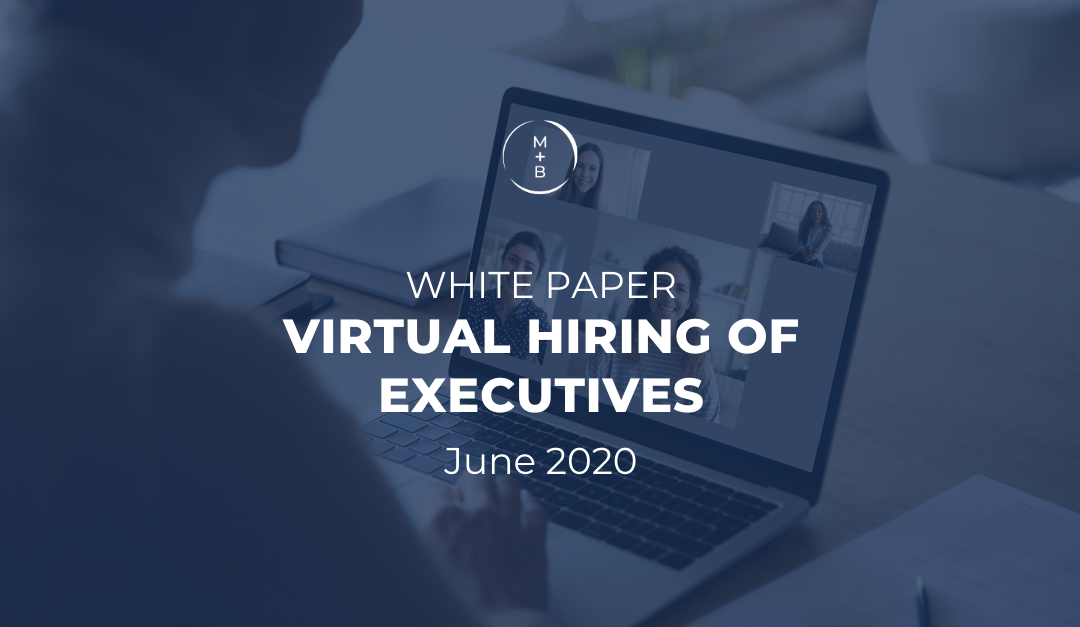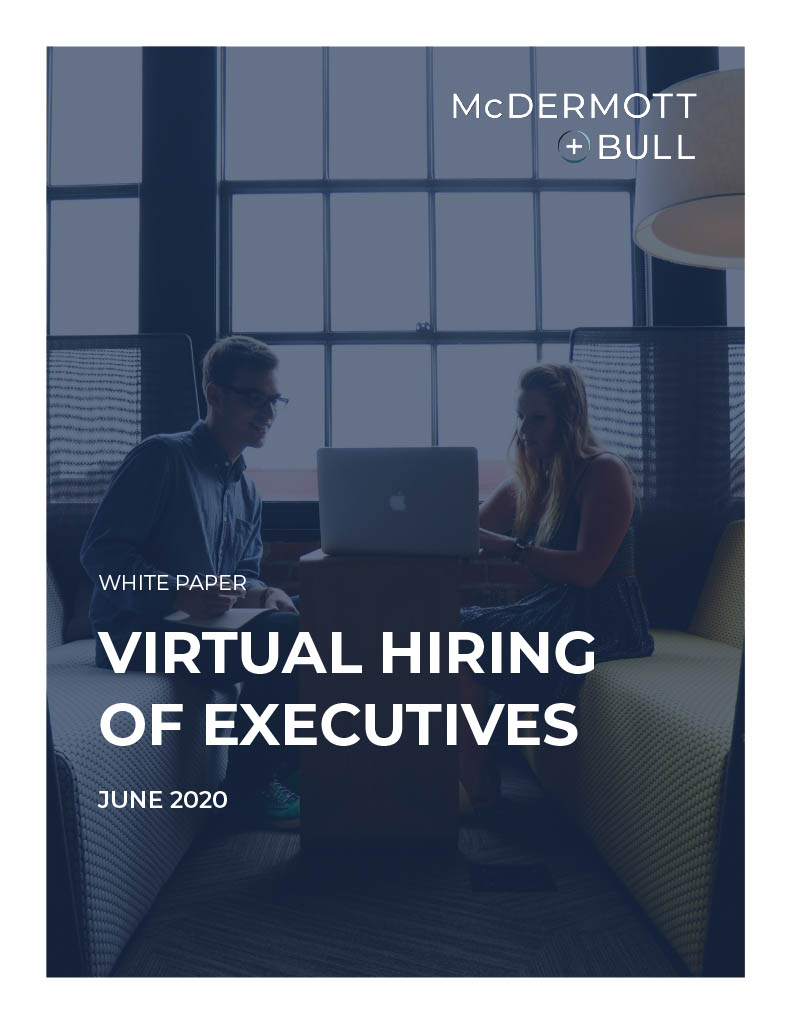VIRTUAL HIRING IS HERE TO STAY
ATTRACTING AND SECURING TOP-LEVEL LEADERSHIP IN THE NEW ERA
The face of business is rapidly evolving in our attempt to keep pace with an increasingly complex and interconnected world. Leadership, at all levels, is the key that makes or breaks any organization’s ability to adapt and thrive, especially during periods of growth or turbulence. This of course heightens the risks involved when companies seek to bring on the right leadership talent for critical executive roles and, rightfully so, as no one wants to get it wrong with a bad hire. When left unchecked, this anxiety has unfortunately led to the creation of some of the most complicated and often cumbersome hiring processes. Not only does this distract from the ultimate goal, but it also diminishes a company’s ability to attract and secure the best candidate. This is clearly counterproductive. The companies that are most prone to success in this new era are the same ones who have already begun to adapt strategically and creatively to the world around them.
IT IS VIRTUALLY IMPOSSIBLE TO TURN AWAY
In case you have missed it, we are going virtual. It is all about accessibility, convenience, and speed. Sure, like any new technology that brings efficiencies, quality can take a hit if not careful. But more often than not, quality is the competitive differentiator that raises the game. We have seen it with the massive changes in how we consume media, sports, and entertainment; interact socially with our daily communications via smart devices; make small and large purchases; network or find companionship and romantic relationships; order our food, buy cars, homes, vacations… the list goes on. Remember how foreign some of these things felt at first? Today, you likely cannot imagine your life without them. There is no turning back. Our increasingly virtual world is here to stay.
"Quality is the competitive differentiator that raises the game."
WORK AS WE KNOW IT IS CHANGING
The workplace has become a testing ground for many virtual tools and forms of communication. This has made it clear that the enhanced collaboration and significant efficiencies of these methods have clear and positive impacts on the bottom line. Today, many businesses are getting ahead of the curve by leveraging remote technologies to allow for more flexible and productive work arrangements and create a new normal for the way employees approach their work. It should not be surprising that hiring processes are also evolving to incur some of the same benefits we have seen through the adoption of virtual tools, while also enhancing the quality of the results and user experience. The companies that get this virtual aspect right will be best positioned to successfully hire their leaders of choice, while the competition struggles to get by with more traditional or outdated approaches to hiring.
WHAT IS THE GOAL?
Regardless of the internal or external factors at play, the goal in any executive leadership search is always the same: find the very best candidate. It starts with coming to a collective understanding of the key results you would like to see for the business, and then work backward to establish an ideal candidate profile that represents the greatest likelihood for success. It is important to clarify that what happens next is not centered on identifying a “perfect” candidate in the real world, as these do not exist. It is really all about identifying the “top” candidate from your strategic pool of targeted prospects. One who is interested, available, affordable, and adaptable, while also being someone you can work well with despite their shortcomings, as we all have them. This subtle but significant shift in mindset can have a powerful impact on the success of any company’s ability to solve for the right problem: how to get the best potential business results, rather than find the perfect candidate. It is also freeing. When vetting potential leadership solutions, it allows unreasonable expectations to be more readily managed and keeps the focus on moving the needle in the right direction for the business. This is true no matter the decided hiring process, whether it be fully traditional, fully virtual, or somewhere in between. That said, with the appropriate goal in mind from the start, you are in a much better place to plan your executive search.
MAKE A GAME PLAN + START PRACTICING
As a hiring executive or search committee, you are in the business of risk mitigation. You are not alone. Remember that the candidates are right there with you, nobody wants to make the wrong move as livelihoods are at stake. Do not forget this mutual risk as you develop your search game plan.
The extent to which you strategically and professionally prepare each aspect of your hiring process will directly correlate with the quality of your ultimate leadership outcome. Once you have overcome the initial anxieties of moving away from solely traditional means of engaging with and interviewing candidates, get aligned on your approach to going virtual. Plan to start small, and begin to leverage virtual tools and processes to complement the in-person process. Over time your comfort level will adjust and, when done right, you will begin to realize benefits in both the efficiency of your process and the quality of the candidates you are engaging. Planning, preparation, and practice diminish risk.
IT IS ALL ABOUT THE CANDIDATES’ EXPERIENCE
Once you have decided what you want as an organization and have a well-thought-out plan, it is no longer about you. Everything moving forward should center around the candidates’ experience. Notice the plural emphasis. Keep in mind that every individual candidate’s experience matters and can have a huge impact on your perceived employer brand in the marketplace. Show your very best at every point in the process while also being true to who you are as an organization and as an individual. Their experience should be top-notch. You will not get there overnight, and there will be some bumps along the way. When this happens, be transparent and open about your intentions in leveraging virtual technology. To the extent possible, troubleshoot in advance, establish backup plans, have how-to documents or instructional videos for both the candidates and your internal team, and provide them with a trusted point of contact or concierge that can assist them at any moment in the process. This is about setting and managing expectations and keeping the human element at the forefront of the virtual tools and technology you are leveraging.
QUALIFY, QUALIFY, QUALIFY
You still have to qualify candidates and they have to qualify you. Fortunately, each stage in the process presents an opportunity for your team to do so, even by virtual means. Most of us probably only consider standard video interviews as part of the virtual process, but it extends much further to a variety of other tools and resources, like digital informational materials, live or pre-recorded video tours, informal group meetings or happy hours, employee and client testimonials, case studies and exercises, personality and leadership assessments, knowledge testing, in-depth reference checking, etc.
By eliminating excess rounds of traditional in-person interviews and appropriately incorporating new virtual elements into the qualifying process, you are not short-changing th process for qualifying candidates. Rather, you are increasing the effectiveness of the process while decreasing the risk and opportunity costs associated with a search that drags on too long or ends in a less-qualified hire. If you are not retooling your hiring process by leveraging some of these virtual aspects in your qualifying process, you are likely missing the mark.
Digital information materials
Informal group meetings or happy hours
Case studies and exercises
Knowledge testing
Live or pre-recorded video tours
Employee and client testimonials
Personality and leadership assessments
In-depth reference checking
DO NOT BE LEFT BEHIND
The world as we know it is forcing businesses to do things they have never done before. Embrace the change. As leaders, we should desire the best outcomes for our companies and for each other. The difference from good to great often comes in the form of the best leader for the job, not the perfect one. Some of the best leadership talent is out there and they, like you, are already going virtual in many aspects of their lives. While physical connection will never fully replace a virtual one, the convenience, efficiency, and effectiveness of utilizing virtual tools in the hiring process cannot be overstated. Companies are already proving that the best candidate can be hired without ever meeting in person.
Someday, we will look back and wonder why we ever went about hiring the way we did, especially for executive leaders. Start today, get aligned, and build your virtual capabilities. Treat those candidates like the executives they are, and give them an experience that will leave them jumping to join you and achieve the business results you are ultimately looking to find.

ABOUT THE AUTHOR + FIRM
Jason Levi Pinegar serves as a Managing Director for McDermott + Bull, based in the firm’s Southern California headquarters. Prior to joining the firm, he served as a Management Consultant with Skulpt Consulting and the Claremont Evaluation Center, with an emphasis in Leadership Assessment and Succession Planning. He earned his MBA with a concentration in Leadership + Managing Organizational Change from Pepperdine University, an MA in Policy + Program Evaluation from Claremont Graduate University, and a BA in Psychology/Sociology from the University of Nevada, Las Vegas.
Leveraging deep vertical experience, innovative thinking, and proven time-saving methodologies, we challenge the norm and thrive in the recruitment of difficult-to find VP to C-Suite executive talent.
We value a personalized service model while having the resources and capabilities of the world’s largest search firms. With experienced partners in Canada, the United States, and Europe, we are the trusted retained search advisor for empowering change on behalf of private and public companies, nonprofit organizations, private equity firms, and their operating companies.


